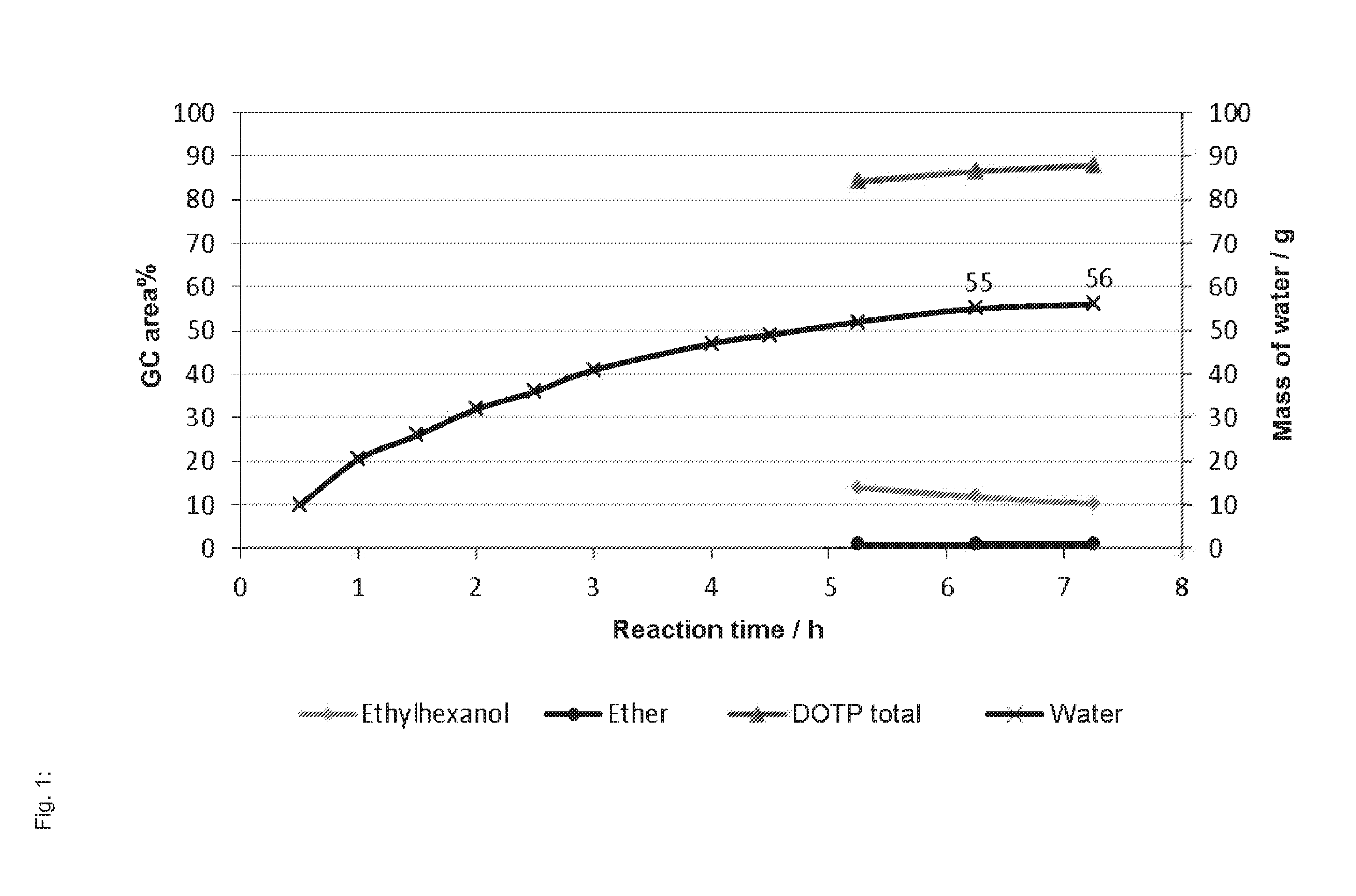Method for producing carboxylic acid esters and the use thereof as plasticizers
a technology plasticizers, which is applied in the separation/purification of carboxylic acid esters, organic chemistry, chemistry apparatuses and processes, etc., can solve the problems of low space-time yield, time-consuming removal, and toxicological concerns
- Summary
- Abstract
- Description
- Claims
- Application Information
AI Technical Summary
Benefits of technology
Problems solved by technology
Method used
Image
Examples
##ventive example 1
Inventive Example 1
Synthesis of DOTP from Terephthalic Acid and 2-Ethylhexanol with MSA as Catalyst
[0208]Terephthalic acid (249 g, 1.50 mol), 2-ethylhexanol (469 g, 3.60 mol), and methanesulfonic acid (Lutropur MSA, BASF, 6.13 g of an approximately 70% by weight aqueous solution, 0.045 mol) are used as initial charge in a 1.6 L double-walled stirred-tank reactor which can be heated by way of a programmable thermostat and has anchor stirrer, Jennewein water separator, condenser, nitrogen inlet, and connection for a vacuum pump, and the reactor is inertized with nitrogen. The nitrogen flow rate through the apparatus was set to from 2 to 4 L h−1, and the reaction mixture was heated to 180° C., whereupon an azeotropic mixture of water and 2-ethylhexanol was formed and liquefied in the condenser, and was passed through to the water separator. After phase separation, the organic phase was returned to the reactor, while the aqueous phase was discarded. The water removed was weighed and use...
##ventive example 2
Inventive Example 2
Synthesis of DOTP from Terephthalic Acid and 2-Ethylhexanol with MSA as Catalyst Under Reduced Pressure
[0209]The reaction was carried out as described in inventive example 1. However, the pressure during the reaction was reduced from 750 mbar to 400 mbar, and the temperature was kept at from 140 to 180° C. Reaction time: 8 h. Yield: 96%. GC content: 97.27% of DOTP (area %).
##ventive example 3
Inventive Example 3
Synthesis of Diisononyl Phthalate (DINP) from Phthalic Anhydride and Isononanol with MSA as Catalyst
[0210]Phthalic anhydride (224 g, 1.50 mol), isononanol (Nonanol N, BASF SE) (519 g, 3.60 mol), and methanesulfonic acid (Lutropur MSA, BASF, 3.07 g of an approximately 70% by weight aqueous solution, 0.023 mol) are used as initial charge in a 1.6 L double-walled stirred-tank reactor which can be heated by way of a programmable thermostat and has anchor stirrer, Jennewein water separator, condenser, nitrogen inlet, and connection for a vacuum pump, and the reactor is inertized with nitrogen. The nitrogen flow rate through the apparatus was set to from 2 to 4 L h−1, and the reaction mixture was heated to 170° C., whereupon an azeotropic mixture of water and isononanol was formed and liquefied in the condenser, and was passed through to the water separator. After phase separation, the organic phase was returned to the reactor, while the aqueous phase was discarded. The...
PUM
| Property | Measurement | Unit |
|---|---|---|
| Temperature | aaaaa | aaaaa |
| Temperature | aaaaa | aaaaa |
| Fraction | aaaaa | aaaaa |
Abstract
Description
Claims
Application Information
 Login to View More
Login to View More - R&D
- Intellectual Property
- Life Sciences
- Materials
- Tech Scout
- Unparalleled Data Quality
- Higher Quality Content
- 60% Fewer Hallucinations
Browse by: Latest US Patents, China's latest patents, Technical Efficacy Thesaurus, Application Domain, Technology Topic, Popular Technical Reports.
© 2025 PatSnap. All rights reserved.Legal|Privacy policy|Modern Slavery Act Transparency Statement|Sitemap|About US| Contact US: help@patsnap.com

